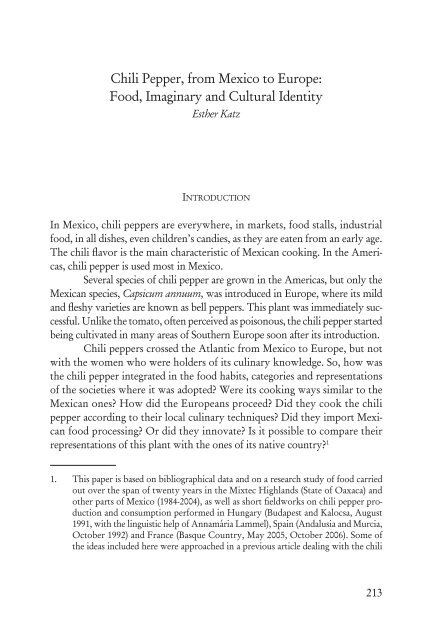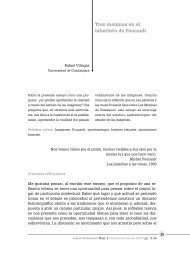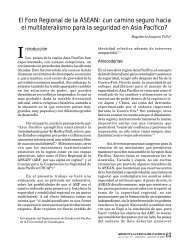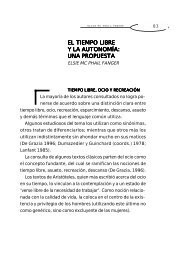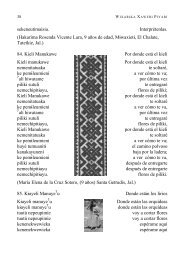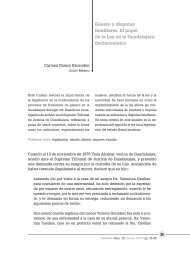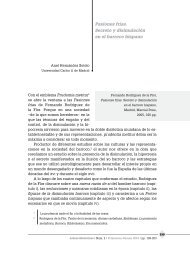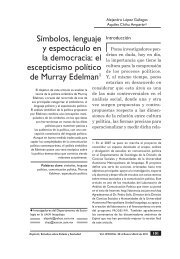Chili Pepper, from Mexico to Europe: Food, Imaginary and Cultural ...
Chili Pepper, from Mexico to Europe: Food, Imaginary and Cultural ...
Chili Pepper, from Mexico to Europe: Food, Imaginary and Cultural ...
Create successful ePaper yourself
Turn your PDF publications into a flip-book with our unique Google optimized e-Paper software.
<strong>Chili</strong> <strong>Pepper</strong>, <strong>from</strong> <strong>Mexico</strong> <strong>to</strong> <strong>Europe</strong>:<br />
<strong>Food</strong>, <strong>Imaginary</strong> <strong>and</strong> <strong>Cultural</strong> Identity<br />
Esther Katz<br />
in t r o d u c t i o n<br />
In <strong>Mexico</strong>, chili peppers are everywhere, in markets, food stalls, industrial<br />
food, in all dishes, even children’s c<strong>and</strong>ies, as they are eaten <strong>from</strong> an early age.<br />
The chili flavor is the main characteristic of Mexican cooking. In the Americas,<br />
chili pepper is used most in <strong>Mexico</strong>.<br />
Several species of chili pepper are grown in the Americas, but only the<br />
Mexican species, Capsicum annuum, was introduced in <strong>Europe</strong>, where its mild<br />
<strong>and</strong> fleshy varieties are known as bell peppers. This plant was immediately successful.<br />
Unlike the <strong>to</strong>ma<strong>to</strong>, often perceived as poisonous, the chili pepper started<br />
being cultivated in many areas of Southern <strong>Europe</strong> soon after its introduction.<br />
<strong>Chili</strong> peppers crossed the Atlantic <strong>from</strong> <strong>Mexico</strong> <strong>to</strong> <strong>Europe</strong>, but not<br />
with the women who were holders of its culinary knowledge. So, how was<br />
the chili pepper integrated in the food habits, categories <strong>and</strong> representations<br />
of the societies where it was adopted? Were its cooking ways similar <strong>to</strong> the<br />
Mexican ones? How did the <strong>Europe</strong>ans proceed? Did they cook the chili<br />
pepper according <strong>to</strong> their local culinary techniques? Did they import Mexican<br />
food processing? Or did they innovate? Is it possible <strong>to</strong> compare their<br />
representations of this plant with the ones of its native country? 1<br />
1. This paper is based on bibliographical data <strong>and</strong> on a research study of food carried<br />
out over the span of twenty years in the Mixtec Highl<strong>and</strong>s (State of Oaxaca) <strong>and</strong><br />
other parts of <strong>Mexico</strong> (1984-2004), as well as short fieldworks on chili pepper production<br />
<strong>and</strong> consumption performed in Hungary (Budapest <strong>and</strong> Kalocsa, August<br />
1991, with the linguistic help of Annamária Lammel), Spain (Andalusia <strong>and</strong> Murcia,<br />
Oc<strong>to</strong>ber 1992) <strong>and</strong> France (Basque Country, May 2005, Oc<strong>to</strong>ber 2006). Some of<br />
the ideas included here were approached in a previous article dealing with the chili<br />
213
FOOD, IMAGINARIES AND CULTURAL FRONTIERS ESSAYS IN HONOUR OF HELEN MACBETH<br />
pepper <strong>and</strong> <strong>to</strong>ma<strong>to</strong> (Katz 1992). Thanks are due <strong>to</strong> farmers <strong>and</strong> consumers of chili<br />
pepper in the regions where fieldwork was done, as well as <strong>to</strong> Janet Long (<strong>Mexico</strong>),<br />
Eszter Kisbán, Maria Molnár, Agota Nagy-Wohl (Budapest), Concepción Obón,<br />
Diego Rivera (Murcia), Françoise Aubaile-Sallenave, Jacques Barrau (†), Laurence<br />
Bérard, Ariane Brune<strong>to</strong>n-Governa<strong>to</strong>ri, Marina Goloubinoff, Aline Hémond,<br />
Annamária Lammel, Anne Luxereau, Marie-Claude Mahias, Philippe Marchenay,<br />
Yves Monnier, Marie-Hélène Sauner-Leroy (France).<br />
2. Andrews (1992, 91) suggests that chili pepper may as well have reached the Eastern<br />
Mediterranean <strong>from</strong> Persia <strong>and</strong> India where the Portuguese were trading spices.<br />
3. But it is not mentioned in Sardinia before the eighteenth century (Guigoni 2001).<br />
214<br />
in t r o d u c t i o n o f ch i l i pepper in eu r o p e<br />
Chris<strong>to</strong>pher Columbus is supposed <strong>to</strong> have brought <strong>to</strong> Spain the first samples<br />
of chili pepper. As Amazonian species (C. chinense <strong>and</strong> frutescens) are more<br />
likely <strong>to</strong> have been the ones cultivated in the West Indies at that time (Heiser<br />
1976), Capsicum annuum may in fact have been brought a few years later<br />
<strong>from</strong> <strong>Mexico</strong> or Central America.<br />
Spain was of course the chili pepper’s first point of arrival in <strong>Europe</strong>.<br />
According <strong>to</strong> Long (1986; 1992), based on Braudel (1949), it became widespread<br />
in this continent through several routes controlled by two empires, Charles V’s<br />
in Western <strong>Europe</strong> (with sea routes established by the Catalans between Spain,<br />
Italy <strong>and</strong> the Middle East) <strong>and</strong> the Ot<strong>to</strong>man empire (exp<strong>and</strong>ing in the Eastern<br />
<strong>and</strong> Southern Mediterranean as well as in the Balkans, up <strong>to</strong> Hungary). 2<br />
Long (1986) distinguished several phases in chili pepper adoption in<br />
<strong>Europe</strong>. <strong>Chili</strong> pepper was first taken <strong>to</strong> botanical <strong>and</strong> aris<strong>to</strong>crats’ gardens as<br />
an ornamental plant or a curiosity (even in cold countries such as Engl<strong>and</strong> or<br />
Germany) <strong>and</strong> was first used as medicine, but after a hundred years it s<strong>to</strong>pped<br />
attracting elites (Long 1992). In the meantime, in the sixteenth century, soon<br />
after its introduction, Spanish farmers started growing it in their gardens<br />
(Monardes 1565-74) <strong>and</strong> using it as a spice. <strong>Pepper</strong>s quickly reached regions<br />
of Southern Italy such as Calabria (Teti 1995), 3 were known in Southwestern<br />
France in the seventeenth century (Prévost 1655; Sabban 1986; Barrau 1991)<br />
<strong>and</strong> arrived in Hungary <strong>from</strong> the Balkans in the early eighteenth century<br />
(Kisbán 1989). They exp<strong>and</strong>ed all over Southern <strong>Europe</strong>, <strong>from</strong> Spain <strong>to</strong> Bul-
CHILI PEPPER, FROM MEXICO TO EUROPE: FOOD, IMAGINARY AND CULTURAL IDENTITY<br />
garia, in regions where climate was appropriate, including continental areas<br />
with hot summers.<br />
When introduced, the chili pepper was immediately considered a<br />
“pepper”. It became “the poor people’s pepper”, as it allowed farmers who<br />
could not afford Asian black pepper <strong>to</strong> spice up their often mono<strong>to</strong>nous food<br />
(Barrau 1991, 343). But the mild peppers were also used as vegetables <strong>and</strong><br />
<strong>Europe</strong>an farmers made them even milder. Bell peppers are probably the<br />
result of a selection made by Italian farmers (Long 1992) <strong>and</strong> the so-called<br />
“<strong>to</strong>ma<strong>to</strong>” <strong>and</strong> “Hungarian wax” peppers were likely selected by Bulgarians. 4<br />
From mid-18th century, <strong>Europe</strong>an elites, starting with the Spaniards<br />
(Luján 1988: 128), became interested in chili pepper again, but this time as a<br />
culinary item. French elites only adopted it in the nineteenth century, using it<br />
in exotic spice compositions (Sabban 1986).<br />
In the same century, when the Continental Blockade limited availability<br />
of black pepper, farmers of the Hungarian Great Plain stepped up chili pepper<br />
production, which later became more industrialized (Somos 1984: 22-25).<br />
In Spain, the regions of Extremadura <strong>and</strong> Murcia also became specialized in<br />
commercial cultivation. Murcia now competes with Hungary over industrial<br />
paprika powder production (Zapata et al., 1992: 20-26). Bell peppers are cultivated<br />
on a large scale in most countries of Southern <strong>Europe</strong> (Somos, ibid.).<br />
cu l i n a r y use o f ch i l i pepper<br />
In <strong>Mexico</strong> there are about a hundred varieties of Capsicum annuum, more or<br />
less spicy, more or less large, with a long or round shape <strong>and</strong> colors varying<br />
<strong>from</strong> pale yellow <strong>to</strong> dark red, but each region has a limited number of local<br />
pepper varieties. Some varieties (serrano, jalapeño/chipotle, poblano/ancho,<br />
guajillo, pasilla, mula<strong>to</strong>) are now cultivated on a wide scale for the national<br />
market. As C. annuum only grows below 1200 m of altitude, dry chili pepper<br />
has always been traded <strong>from</strong> the lowl<strong>and</strong>s <strong>to</strong> the highl<strong>and</strong>s, which are the<br />
4. “Hungarian wax peppers” (fehérözönpaprika) were introduced in Hungary by Bulgarians<br />
in the nineteenth century <strong>and</strong> “<strong>to</strong>ma<strong>to</strong> peppers” (paradicsompaprika) in the<br />
twentieth (Somos: 1984, 22-25). The latter are common in Bulgarian salads (Chauvet,<br />
in preparation).<br />
215
FOOD, IMAGINARIES AND CULTURAL FRONTIERS ESSAYS IN HONOUR OF HELEN MACBETH<br />
most populated areas. A highl<strong>and</strong> species, C. pubescens, was introduced <strong>from</strong><br />
the Andes in the twentieth century, but it is seasonal <strong>and</strong> cannot be dried.<br />
Chile habanero (“<strong>from</strong> Havana”), a variety of the Amazonian species C. chinense,<br />
is cultivated in the Yucatan peninsula (Long 1986).<br />
Capsicum annuum is eaten fresh when it is green (immature) or yellow<br />
<strong>and</strong> dried when it is red (mature). Usually, only C. pubescens <strong>and</strong> chinense are<br />
always eaten fresh, green or mature, as they are fleshy. On the Gulf Coast,<br />
one variety (chipotle, called jalapeño when fresh) is smoked (chilpoctli means<br />
“smoked chili pepper” in Nahuatl). 5<br />
In <strong>Mexico</strong>, most dishes, especially beans <strong>and</strong> stews, are cooked with<br />
small green or dry chili peppers. Dry chili pepper is also the base for meat<br />
stew sauces <strong>and</strong> marinades (adobo, recado). Even though the dishes are already<br />
spiced up, more chili may be added, so it is always put on the table, either fresh<br />
or in a sauce (salsa picante). When fresh, small green chili peppers are nibbled<br />
with the food or added <strong>to</strong> the dish, chopped, cut in<strong>to</strong> slices or as pickles. 6 Hot<br />
sauces are common all over Latin America (Lambert Ortiz 1984), but the<br />
Mexican salsas have a specific <strong>to</strong>uch. At its bare minimum, salsa is made of<br />
chili pepper, salt <strong>and</strong> water. More commonly, it is associated with red <strong>to</strong>ma<strong>to</strong>es<br />
or green husk <strong>to</strong>ma<strong>to</strong>es, 7 onions, garlic <strong>and</strong> often cori<strong>and</strong>er leaves. 8 Many<br />
more ingredients may be added (squash seeds, avocado, etc.). The ingredients<br />
are either raw or boiled, grilled or fried, then ground with water in a s<strong>to</strong>ne<br />
mortar (molcajete) or more commonly now in a blender (licuadora), the main<br />
electric appliance found in Mexican homes. The color of the sauce depends on<br />
the color of the chili pepper (green or light <strong>to</strong> dark red), of the <strong>to</strong>ma<strong>to</strong> (green<br />
or red) <strong>and</strong> the herbs. Some raw salsas are not blended but made with diced<br />
green chili pepper, <strong>to</strong>ma<strong>to</strong>, onions, garlic <strong>and</strong> cori<strong>and</strong>er leaves, which is also<br />
the base for guacamole <strong>and</strong> “Mexican style” (a la mexicana) dishes (beefsteak,<br />
5. Cf. Siméon, 1977.<br />
6. Pickles were a Spanish introduction. Not many people know how <strong>to</strong> prepare them.<br />
<strong>Chili</strong> pickles are commonly found canned or in jars, industrially produced.<br />
7. The common red <strong>to</strong>ma<strong>to</strong> (ji<strong>to</strong>mate) is Solanum lycopersicum <strong>and</strong> the smaller green<br />
husk <strong>to</strong>ma<strong>to</strong>es (<strong>to</strong>mate de cascara) are different species of cultivated or wild Physalis<br />
(Ph. ixocarpa <strong>and</strong> philadelphica are the most common ones).<br />
8. The last three plants were introduced by the Spaniards.<br />
216
CHILI PEPPER, FROM MEXICO TO EUROPE: FOOD, IMAGINARY AND CULTURAL IDENTITY<br />
scrambled eggs, cactus salad, etc.). Salsas of different kinds are cooked all over<br />
<strong>Mexico</strong>, each region with specific recipes. 9 In some areas, especially in Guerrero<br />
(Marina Goloubinoff, personal communication, 1993) or Oaxaca, the<br />
sauce, sometimes enriched with beans, pota<strong>to</strong>es, avocado, sesame seeds or hog<br />
plums, may be turned in<strong>to</strong> a main dish if there is nothing else <strong>to</strong> eat. When<br />
working in the fields, farmers often just eat <strong>to</strong>rtillas filled up with chili sauce.<br />
The Nahua name for salsa, chilmolli–“chili sauce or dish” 10 in Mexican<br />
Spanish chilmole or chirmole– creates an ambiguity between salsa <strong>and</strong> what<br />
is now called mole, a thick chili sauce typical of central <strong>Mexico</strong> <strong>and</strong> Oaxaca,<br />
eaten as a main dish. Shortly after the Conquest, the Spanish friar Bernardino<br />
de Sahagún described a great variety of chilmolli in the Central Mexican<br />
Highl<strong>and</strong>s, which may be either one of the two preparations (Sahagún 1999).<br />
In present-day Guerrero Nahuatl, chilmohli <strong>and</strong> chihli refer <strong>to</strong> the salsa <strong>and</strong><br />
mohli <strong>to</strong> the mole (Marina Goloubinoff, personal communication, 1993). In<br />
Mixtec, the sauce, (nde yaha, “chili water”) is well differentiated <strong>from</strong> the mole<br />
(neyu uhwa, “thick dish or broth”). To make mole, dry (large) chili peppers<br />
are ground on a corn grinding s<strong>to</strong>ne or in an electric blender <strong>and</strong> mixed with<br />
other ingredients in<strong>to</strong> a paste, usually fried in a big pan <strong>and</strong> diluted little by<br />
little with a meat or vegetable broth. The meat, vegetables or beans are previously<br />
boiled <strong>and</strong> added at the end. There are many sorts of mole: “green”<br />
(often with squash seeds), “yellow” (with light red chili), “red” (colorado) or<br />
“black” (with dark chili, burnt <strong>to</strong>rtillas <strong>and</strong> cocoa). Mole is rooted in prehispanic<br />
indigenous traditions, but the different recipes, especially the mole<br />
poblano, a black mole <strong>from</strong> Puebla highly appreciated all over the country,<br />
were enriched in the colonial period by Spanish imported ingredients (onions,<br />
garlic, herbs, almonds, sesame seeds, etc.) <strong>and</strong> techniques, such as frying. 11<br />
9. But there are no chili sauces in the cooking of the Mayan Indians of the Chiapas<br />
Highl<strong>and</strong>s (Petrich 1985; Helios Figuerola, personal communication, 2005).<br />
10. Siméon 1977.<br />
11. Mole poblano is said <strong>to</strong> have been created in a convent of Puebla at the end of the<br />
seventeenth century for a banquet served <strong>to</strong> the vice-king (Pérez San Vicente 1988:<br />
19). Several of its ingredients are typical of the Arab-Andalusian medieval cooking<br />
(Bolens 1990). A present-day Moroccan fast-breaking dish, sellou, is made according <strong>to</strong><br />
the same technique: almonds, sometimes walnuts, <strong>and</strong> sesame seeds are fried separately<br />
<strong>and</strong> blended in<strong>to</strong> a paste with <strong>to</strong>asted flour, gum Arabic, cinnamon <strong>and</strong> honey).<br />
217
FOOD, IMAGINARIES AND CULTURAL FRONTIERS ESSAYS IN HONOUR OF HELEN MACBETH<br />
Large green chili peppers are consumed as vegetables, more commonly<br />
in cities, with Spanish recipes: fried rajas de chile (chili strips) are also<br />
cooked in Spain, as well as stuffed chilis (chile relleno), filled with meat or<br />
cheese. Bell peppers, reintroduced in the twentieth century, mainly appeal<br />
<strong>to</strong> people with <strong>Europe</strong>an cooking traditions (Long 1986). Dry chili powder<br />
is rarely used. It is added <strong>to</strong> fruit slices sold on the street <strong>and</strong> industrial foods<br />
such as corn chips or c<strong>and</strong>ies.<br />
In <strong>Europe</strong>, chili pepper was first acknowledged as a spice, then also used<br />
as a vegetable. Either green or red peppers may be eaten fresh. Dry chili pepper<br />
is cooked in soups <strong>and</strong> stews, as fresh pepper, but it is more commonly turned<br />
in<strong>to</strong> a spice powder like black pepper. Under the Hungarian name “paprika,” it<br />
is now used all over <strong>Europe</strong>. Traditionally, in Hungary, Spain, Southern Italy<br />
<strong>and</strong> French Basque country, where it is always on the table with salt <strong>and</strong> black<br />
pepper, it spices up hams, sausages <strong>and</strong> many other dishes (Luján 1988; Teti<br />
1995; Raineau 1993). 12 The fresh hot peppers may be preserved in salt, oil or<br />
vinegar, the same way as (or <strong>to</strong>gether with) cucumbers, onions or beets.<br />
The large mild chili or bell peppers (it may be difficult <strong>to</strong> distinguish<br />
them) are consumed as vegetables. Raw, grilled, fried or boiled, alone or with<br />
other vegetables, they may be eaten as a salad or in a side dish (like rata<strong>to</strong>uille<br />
or peperonata). They may be stuffed, which is very common in Eastern Mediterranean<br />
cooking. 13 Cooked red peppers may be mashed in a coulis or a sauce<br />
(in Hungary, “<strong>to</strong>ma<strong>to</strong> peppers” are condensed like a <strong>to</strong>ma<strong>to</strong> sauce).<br />
Mexican <strong>and</strong> <strong>Europe</strong>an ways of using chili pepper are actually quite<br />
different. There was no culinary technique transfer <strong>from</strong> <strong>Mexico</strong> <strong>to</strong> <strong>Europe</strong>,<br />
but rather a re-appropriation according <strong>to</strong> local food categories (spice, vegetable)<br />
<strong>and</strong> techniques (preserves, vegetable stews, etc.). Some <strong>Europe</strong>an preparations<br />
(pickles, stuffed vegetables) also traveled the other way, as well as mild<br />
varieties that went through a further selection process. On the other h<strong>and</strong>,<br />
neither Mexican style salsas, nor mole were taken <strong>to</strong> <strong>Europe</strong>. Both remain<br />
emblematic of Mexican cuisine.<br />
12. In Bresse (Eastern France), the poivre rouge (red pepper) spices up a local cheese<br />
(Bérard & Marchenay 2004).<br />
13. The traditional stuffed vegetables are eggplants <strong>and</strong> vine leaves. American peppers,<br />
<strong>to</strong>ma<strong>to</strong>es <strong>and</strong> zucchinis followed the same recipes.<br />
218
CHILI PEPPER, FROM MEXICO TO EUROPE: FOOD, IMAGINARY AND CULTURAL IDENTITY<br />
Culinary uses of chili pepper in <strong>Europe</strong> <strong>and</strong> <strong>Mexico</strong><br />
MEXICO EUROPE<br />
Small fresh (green) hot pepper Small fresh (green/red) hot pepper<br />
As such, whole or in pieces As such<br />
In vinegar In vinegar, oil or salt<br />
In dishes (broths, stews…) In dishes (soups, stews…)<br />
In salsa<br />
In dishes “a la mexicana”<br />
Large fresh (green) mild pepper Mild (green/red/yellow) chili/bell pepper<br />
Fried chili strips In salad (raw, fried, grilled, boiled)<br />
Stuffed chili peppers In vegetable stews (“rata<strong>to</strong>uilles”,…)<br />
Stuffed pepper (green/yellow)<br />
Mashed, condensed sauce, coulis (red)<br />
Dry chili pepper Dry chili pepper<br />
In powder > chips, fruits, sweets In powder > on the table, in dishes<br />
Whole > in dishes Whole > in dishes<br />
Ground Small chilis > salsas, stews Ground > in hams <strong>and</strong> sausages<br />
Large chilis > moles, adobos<br />
Smoked chili pepper (chipotle) Smoked chili pepper (pimentón de la Vera)<br />
Whole, in salsa In sausages, dishes<br />
Green <strong>and</strong> red, fresh <strong>and</strong> dry<br />
th e imaginary o f ch i l i pepper<br />
Why is red chili pepper not eaten fresh in <strong>Mexico</strong>? Why is green/fresh<br />
opposed <strong>to</strong> red/dry? We have <strong>to</strong> find clues in the complex color symbolism<br />
of the indigenous cultures.<br />
In classical Nahuatl, the language of the Aztecs, xoxouhqui refers both<br />
<strong>to</strong> “green” <strong>and</strong> “raw”. The green color was attributed <strong>to</strong> immature plants,<br />
the yellow <strong>and</strong> red color <strong>to</strong> mature plants (Dupey 2004: 22-30). The rainy<br />
season was called xopan, the “green period” (Dupey 2004), in reference <strong>to</strong> the<br />
renewal of the vegetation, <strong>and</strong> green chili was associated with the Rain God,<br />
as the green color symbolizes water (Long 1990).<br />
219
FOOD, IMAGINARIES AND CULTURAL FRONTIERS ESSAYS IN HONOUR OF HELEN MACBETH<br />
For the Mixtec Indians of Oaxaca (Katz 2005), who share many cultural<br />
features with the Central Highl<strong>and</strong>s Indians, food symbolism refers <strong>to</strong> dry <strong>and</strong><br />
rainy seasons. Wet <strong>and</strong> dry are two implicit food categories, mainly expressed<br />
in cooking terms, <strong>and</strong> combine with the hot <strong>and</strong> cold categories. For sowing<br />
corn, the ideal time, the climax of fertility, occurs when the earth, warmed up<br />
by the sun during the dry season, receives the first rains. Likewise, the ideal diet<br />
must combine heat <strong>and</strong> water: it must be warm, not <strong>to</strong>o hot, <strong>and</strong> liquid. So dry<br />
hot foods or wet cold foods alone are avoided. <strong>Chili</strong> pepper always makes food<br />
warm. Fresh green chili may be eaten alone (as it is hot/wet), while dry red chili<br />
(hot/dry) must be cooked or soaked in water first. <strong>Chili</strong> sauces are always made<br />
by grinding or blending the ingredients with water.<br />
In classical Nahuatl, again, the main term for the red color, chilchitic,<br />
derives <strong>from</strong> chilli <strong>and</strong> eztli (blood). As chili pepper is supposed <strong>to</strong> be a “hot”<br />
food, red is a “hot” color (Dupey 2004). In present-day Guerrero Nahuatl,<br />
the word for the orange color is chillia<strong>to</strong>lli, a<strong>to</strong>lli being a thick white corn<br />
beverage (Hémond 2003). Colors of mole dishes are obtained by light or dark<br />
shades of dry peppers mixed with light or dark foods: “Yellow” mole is made<br />
of light red guajillo pepper mixed with white corn dough, “black” mole is<br />
made of dark peppers mixed with chocolate <strong>and</strong> <strong>to</strong>asted <strong>to</strong>rtillas. Color inten- intensity<br />
<strong>and</strong> shade are notions expressed in pre-Hispanic <strong>and</strong> present Nahua color<br />
terms (Dupey 2004; Dehouve 1978: 298).<br />
Red <strong>and</strong> green are opposed <strong>and</strong> complementary. For the Aztecs, “jade, being<br />
green, represented the precious water, which is ‘the blood of the vegetation’,<br />
associated, in an opposing pair, <strong>to</strong> red, the color of blood” (Duverger 1979).<br />
During the Fire God festival, Aztecs served a combination of green <strong>and</strong> red<br />
dishes (Dupey 2004). In their paintings, present-day Guerrero Nahua clothbark<br />
painters often associate these two colors, which are seen as complementary<br />
(Hémond 2003). For a harvest festival at the end of the rainy season, in<br />
Olinala, Guerrero, fresh green <strong>and</strong> red chili peppers are set <strong>to</strong>gether in marigold<br />
bouquets <strong>and</strong> collars adorning the church <strong>and</strong> the saints (Long 1993).<br />
Green is related <strong>to</strong> the rainy season <strong>and</strong> fertility, but so is red when<br />
associated with black. In ancient Nahua iconography, the rainy season is represented<br />
by a combination of red <strong>and</strong> black, while the red-white combination<br />
represents the dry season (Dupey 2003:107-117). In contemporary Guerrero<br />
Nahua ceramics, red <strong>and</strong> black are always associated <strong>and</strong> represent the<br />
220
CHILI PEPPER, FROM MEXICO TO EUROPE: FOOD, IMAGINARY AND CULTURAL IDENTITY<br />
earth (Hémond 2003). For present-day O<strong>to</strong>mis of central <strong>Mexico</strong> (Galinier<br />
1990:513-524), red, related <strong>to</strong> blood <strong>and</strong> female genitals, <strong>and</strong> black, <strong>to</strong> night<br />
<strong>and</strong> cavity, are the main colors of the underworld, the place of origin of the<br />
fertility, according <strong>to</strong> all Mexican indigenous cultures (López Austin 1988).<br />
This type of color contrast is still sought in present-day Mexican cooking,<br />
be it rural or urban. Green <strong>and</strong> red are associated in raw diced salsas <strong>and</strong><br />
“Mexican-style” dishes <strong>and</strong> other salsas are either red or green. “Yellow”, red<br />
or black moles are festive dishes. Black mole, in particular, is served at weddings.<br />
More or less unconsciously, Mexican people, even nowadays, keep<br />
eating foods that are symbols of fertility.<br />
In <strong>Europe</strong>, there is also a distinction between red <strong>and</strong> green, although<br />
it does not systematically refer <strong>to</strong> a distinction between fresh <strong>and</strong> dried, as<br />
in <strong>Mexico</strong>. Green, yellow or red chili or bell peppers may be eaten fresh.<br />
Creating color schemes by blending green <strong>and</strong> red peppers–or pepper <strong>and</strong><br />
<strong>to</strong>ma<strong>to</strong>– in the same dish is common in the Mediterranean. The red color<br />
is particularly sought for its culinary aesthetic value. In Spain, red pepper<br />
strips decorate white or saffron rice dishes. For Hungarians, the most important<br />
characteristic of paprika is the intensity of the red color. 14 Nowadays,<br />
pepper oleoresin <strong>and</strong> powder are employed in the food industry as dye (Long<br />
1986: 115-123). Barrau (1991: 343-344) suggests that the red color played an<br />
important role in the introduction of peppers <strong>and</strong> <strong>to</strong>ma<strong>to</strong>es in <strong>Europe</strong>, where<br />
there were few red foods before their arrival: he recalls that these “immoral<br />
red fruits” were said <strong>to</strong> be aphrodisiac <strong>and</strong> stimulate appetites. In <strong>Europe</strong>,<br />
the color red is related <strong>to</strong> blood <strong>and</strong> fire, <strong>and</strong> therefore <strong>to</strong> heat, anger, vital<br />
<strong>and</strong> sexual energy. According <strong>to</strong> the Calabrians, chili pepper is hot <strong>and</strong> gives<br />
strength (Teti 1995). Hungarians claim the same <strong>and</strong> say that peppers ‘heat<br />
up your blood’ or ‘make it boil;’ ‘To be like pepper’ (paprikás), means <strong>to</strong> be<br />
angry, agitated or nervous (Halász 1987: 58-59).<br />
14. In Hungarian, the saying “<strong>to</strong> blush like a <strong>to</strong>ma<strong>to</strong>” translates in<strong>to</strong> “<strong>to</strong> blush like a<br />
paprika” (paprikapiros).<br />
221
FOOD, IMAGINARIES AND CULTURAL FRONTIERS ESSAYS IN HONOUR OF HELEN MACBETH<br />
<strong>Pepper</strong>s as a sex symbol<br />
In <strong>Europe</strong>, red is reminiscent of sexuality, but pepper is more than just red: it<br />
has a phallic shape <strong>and</strong> is “spicy” or “hot.” <strong>Pepper</strong>s in Hungary are a symbol<br />
of virility: men add more paprika <strong>to</strong> their food than women <strong>and</strong> in Kalocsa<br />
a pepper variety is labeled “cat penis”. In Calabria, a pepper bears the same<br />
name <strong>and</strong> another, rounder variety, is called “rooster testicle”. <strong>Pepper</strong> is often<br />
cooked in a specific sausage, which is also phallic, <strong>and</strong> both foods are supposed<br />
<strong>to</strong> have exciting <strong>and</strong> aphrodisiac properties; 15 pepper is used as remedy<br />
against frigidity (Teti 1995). In the nineteenth century, Basques used <strong>to</strong> burn<br />
dried peppers as incense during wedding ceremonies (Raineau 1993).<br />
In <strong>Mexico</strong>, pepper is also a symbol of virility. Men eat hotter foods<br />
than women; notably they nibble whole green peppers more often, <strong>and</strong> show<br />
off when it makes them sweat. Mexican slang <strong>and</strong> several indigenous languages<br />
use “pepper” (chile) as a synonym for the virile member. “Because both<br />
will heat bodies,” Mocho Indians (Mayas <strong>from</strong> Chiapas) will tell you with a<br />
smile on their faces (Petrich 1985: 106). <strong>Pepper</strong> is considered an aphrodisiac<br />
<strong>and</strong> associated with sexual desire. 16 And if overheated when grilled, it is said<br />
<strong>to</strong> “explode <strong>and</strong> spill its tiny seeds” (Aline Hémond, personal communication,<br />
2004). <strong>Chili</strong> pepper refers <strong>to</strong> vital <strong>and</strong> sexual heat not only because of its<br />
phallic shape, but also because it is indeed a “hot” food, both in reality <strong>and</strong><br />
symbolically. As seen above, certain foods are regarded as “hot” or “cold”;<br />
human beings as well can be regarded as more or less “hot” throughout their<br />
lifespan: individuals are “cold” when born <strong>and</strong> progressively acquire heat,<br />
peaking when adulthood begins <strong>and</strong> gradually losing it as they grow old. 17<br />
Intake of “hot” foods aims at maintaining this vital heat. As pepper is par-<br />
15. In a recent Calabrian trade show, a pepper preparation was sold as “Viagra for the<br />
poor” (Zoschke, 2007).<br />
16. See the pre-Hispanic legend of the god Tezcatlipoca disguised as a stark naked<br />
Huastec merchant who was selling green peppers <strong>and</strong> turned the daughter of the<br />
Toltec king mad with desire at the sight of his ana<strong>to</strong>my (Sahagún 1999, book III:<br />
197-198 <strong>and</strong> quoted in Long 1990).<br />
17. This conception of the life cycle, analysed in detail for the Aztecs by López Austin<br />
(1980), is common <strong>to</strong> present-day Mexican people of Indian descent.<br />
222
CHILI PEPPER, FROM MEXICO TO EUROPE: FOOD, IMAGINARY AND CULTURAL IDENTITY<br />
ticularly “hot,” it does more than maintaining vital heat, it gives strength <strong>and</strong><br />
fosters sexual activity, thus enabling proliferation of offspring.<br />
<strong>Pepper</strong>s as identity markers<br />
While taste for sweet is innate, taste for peppers is gradually acquired during<br />
child socialization <strong>and</strong> culturally nurtured (Rozin & Rozin 1981, Fischler<br />
1990). The chili taste is for Mexicans what E. Rozin (1973) calls a “flavoring<br />
principle” a basic flavor which gives a specific identity <strong>to</strong> the food. Mexican<br />
food without chili is not Mexican food anymore.<br />
As chili pepper marks the specificity of the Mexican cuisine, it also<br />
draws cultural borders. Beyond the Guatemalan border food is not spicy<br />
enough for a Mexican, even though pepper is consumed there in nearly<br />
the same manner. <strong>Pepper</strong> is used in almost all Latin American cuisines, but<br />
nowhere is it as important as in Mexican cuisine, where it is a symbol of<br />
national identity. 18 Above all, peppers mark the cultural frontier between<br />
<strong>Mexico</strong> <strong>and</strong> the United States. They have the reputation of being unbearable<br />
<strong>to</strong> the palate of a gringo. Nonetheless, the Mexican frontier used <strong>to</strong> be further<br />
north, <strong>and</strong> the Southwestern United States has preserved some of its Mexican<br />
roots. Furthermore, the demographic weight of Hispanic minorities is constantly<br />
increasing, along with their cultural influence. <strong>Pepper</strong>s have thus been<br />
gaining new adepts (chiliheads) in the United States (Robbins 1992). Gourmet<br />
magazines specializing in chili pepper are quite successful 19 <strong>and</strong> pepper festivals<br />
are held in California, Texas, <strong>and</strong> New <strong>Mexico</strong> (Jackson 2004). A whole<br />
institute at New <strong>Mexico</strong> State University (www.chilepepperinstitute.org) is<br />
dedicated <strong>to</strong> chili pepper agronomy research.<br />
18. In the city of Puebla, Independence Day is celebrated with a pepper dish bearing<br />
the colors of the national flag (green, white, red), the famous chiles en nogada, a local<br />
dish attested since the eighteenth century, consisting of green peppers stuffed with<br />
meat <strong>and</strong> tiny bits of fruit, covered with a white sauce of walnuts <strong>and</strong> sprinkled<br />
with red pomegranate seeds (Pérez San Vicente 1988, 21).<br />
19. Several printed or on-line magazines are dedicated <strong>to</strong> chili pepper; a specialized gourgourmet magazine named Chile <strong>Pepper</strong> Magazine, created in 1987, had 55,000 subscribers<br />
in 1992 (Robbins, 1992); it is now printed every two months (www.chilepepper-<br />
(www.chilepeppermag.com),<br />
as Fiery <strong>Food</strong>s, created in 1997 (www.fiery-foods.com).<br />
223
FOOD, IMAGINARIES AND CULTURAL FRONTIERS ESSAYS IN HONOUR OF HELEN MACBETH<br />
Even within <strong>Mexico</strong>, pepper intake varies among regions, social or<br />
ethnic groups <strong>and</strong> persons. Those who eat the spiciest foods are Indian peasants,<br />
especially in the Central Highl<strong>and</strong>s 20 <strong>and</strong> the State of Oaxaca. From a regional<br />
st<strong>and</strong>point, the hottest species, namely the habanero pepper, is grown in the<br />
Yucatan, a lowl<strong>and</strong> peninsula populated by Maya Indians; however, in the Chiapas<br />
Highl<strong>and</strong>s, Maya Indians do not eat very hot food (Hélios Figuerola, pers.<br />
comm., 2005). Everywhere, the hot flavors are diluted in <strong>to</strong>wns, <strong>to</strong> a greater<br />
extent among middle classes <strong>and</strong> especially among those of <strong>Europe</strong>an origin,<br />
although the latter tend <strong>to</strong> get used <strong>to</strong> peppers over the span of one generation.<br />
In the Central <strong>and</strong> Southern regions, where the percentage of indigenous population<br />
is high, peppers enhance an otherwise mono<strong>to</strong>nous cuisine based on<br />
<strong>to</strong>rtillas <strong>and</strong> beans. Many Indians in these regions live in poverty <strong>and</strong> are seen<br />
by others as backwards. The Mixtecs of Oaxaca, for instance, tend <strong>to</strong> denigrate<br />
themselves, but, at the same time, in contrast with the finesse <strong>and</strong> weakness of<br />
city-dwellers, they take pride in their strength, endurance <strong>and</strong> ability <strong>to</strong> make a<br />
living in a rugged environment (Katz 1991). Eating more spicy foods than the<br />
city folk is part of that logic: as they say, “we are strong, since we eat nothing<br />
but pepper” (somos fuertes porque comemos puro chile).<br />
In <strong>Europe</strong>, pepper has also become a regional or national identity<br />
marker. In Italy, since pepper is not grown <strong>and</strong> eaten by their close neighbors,<br />
Calabrians have adopted it as a significant element of their identity,<br />
which they carry along with them when migrating <strong>to</strong> the United States. The<br />
pepper perfectly symbolizes cultural traits commonly attributed <strong>to</strong> Calabrian<br />
peasants, closely resembling those of Mexican indigenous peasants: primitive,<br />
vigorous in a hostile environment, <strong>and</strong> gifted with a strong identity which<br />
they defend <strong>from</strong> the denials of outsiders (Teti 1995). Basques <strong>from</strong> Espelette<br />
compare the color of peppers <strong>to</strong> that of their flag <strong>and</strong> use peppers, which<br />
decorate their house fronts, as a <strong>to</strong>urist attraction (Raineau 1993), but also <strong>to</strong><br />
distinguish themselves <strong>from</strong> their Bearnese neighbors who eat mild instead of<br />
spicy peppers (Brune<strong>to</strong>n-Governa<strong>to</strong>ri, pers. comm., 1993). 21<br />
20. According <strong>to</strong> David Robichaux (personal communication, 2005), the Nahua Indians<br />
of the State of Tlaxcala eat the hottest food of all <strong>Mexico</strong>.<br />
21. According <strong>to</strong> the Basques, Bearnese pipérade is not a pepper dish like their own, but<br />
a <strong>to</strong>ma<strong>to</strong> dish (“c’est de la <strong>to</strong>mataille”), (Brune<strong>to</strong>n-Governa<strong>to</strong>ri, personal communication,<br />
1993).<br />
224
CHILI PEPPER, FROM MEXICO TO EUROPE: FOOD, IMAGINARY AND CULTURAL IDENTITY<br />
In Hungary, paprika has become a symbol of national identity. Kisbán<br />
(1989) retraced this process through the his<strong>to</strong>ry of goulash. This beef stew was<br />
prepared out in the fields by cattle herders in the Great Plain, where peppers<br />
were first introduced. This gulyás hús (cowherd meat) or pörkölt (stew) <strong>to</strong>ok<br />
on the name paprikás hús (paprika meat) at the end of the eighteenth century,<br />
indicating introduction of paprika <strong>and</strong>, at that time, extended its popularity<br />
<strong>to</strong> regional farmers <strong>and</strong> taverns. In 1790, Hungarian nobility came in<strong>to</strong> conflict<br />
with the Austrian Monarchy in the process of building a unified Austro-<br />
Hungarian empire. The romantic view of peasant culture was then in fashion<br />
throughout <strong>Europe</strong>. Hungarian nobles thus drew symbols of national identity<br />
<strong>from</strong> folk culture, in order <strong>to</strong> distinguish themselves <strong>from</strong> Austrian nobles,<br />
with whom they shared many cultural traits. Until then, sauerkraut with meat,<br />
eaten throughout Central <strong>Europe</strong>, was considered the Hungarian national dish.<br />
By an “invention of tradition,” 22 Hungarian nobles established goulash as the<br />
national dish, as it was specific <strong>to</strong> a Hungarian region <strong>and</strong>, thanks <strong>to</strong> the paprika<br />
flavor, distinct <strong>from</strong> other Central <strong>Europe</strong>an cuisines. Goulash thus became a<br />
true success in Hungary <strong>and</strong> later throughout the rest of <strong>Europe</strong>. Its image as<br />
a national dish faded at one point, but regained strength with <strong>to</strong>urism <strong>and</strong> as a<br />
symbol of identity among Hungarian immigrants in North America.<br />
Regional identity of pepper-producing regions has been enhanced<br />
through pepper trade shows. For the last years, such food festivals have been<br />
held annually in Diamante in Calabria, Espelette in the Basque Country <strong>and</strong><br />
Kalocsa in the Hungarian Great Plain, where pepper museums were created<br />
(Raineau 1993; Jackson 2004; Hudgins 2004; Zoschke 2004). <strong>Pepper</strong> has<br />
become a <strong>to</strong>urist attraction as well as an agricultural <strong>and</strong> cultural heritage.<br />
Currently, some regions claim peppers as “produits de terroir” (Bérard<br />
& Marchenay 1995; 2004). 23 Farmers in Cáceres (Extremadura, Spain), Navarra<br />
(Spain) <strong>and</strong> Espelette (French Basque Country) obtained a “geographical indication”<br />
for their peppers, a certification also sought by Padrón (Galicia, Spain). 24<br />
22. According <strong>to</strong> the definition minted by Hobsbawm & Ranger (1983).<br />
23. The French term “produit de terroir” is applied <strong>to</strong> localized, traditional, transmitted<br />
productions; they are usually developed in a terri<strong>to</strong>ry according <strong>to</strong> specifi specific c knowledge<br />
linked <strong>to</strong> local traditions (Bérard & Marchenay 2004).<br />
24. For the varieties labeled pimentón de la Vera (Cáceres), piquillo de Lodosa (Navarra),<br />
piment d’Espelette. “A geographical indication is a sign used on goods that have a<br />
225
FOOD, IMAGINARIES AND CULTURAL FRONTIERS ESSAYS IN HONOUR OF HELEN MACBETH<br />
<strong>Pepper</strong>s became a part of traditional cultures, by means of “invention of tradition”<br />
as well as know-how unique <strong>to</strong> each terri<strong>to</strong>ry. 25 The processes of plant<br />
selections carried out over the centuries by farmers of different <strong>Europe</strong>an<br />
regions are now being acknowledged. But economic stakes are also present <strong>and</strong><br />
these new measures may also have an impact on the evolution of the management<br />
of these products <strong>and</strong> the agricultural heritage. These issues are moving<br />
quickly, so it is hard <strong>to</strong> forecast the future.<br />
specific geographical origin <strong>and</strong> possess qualities or a reputation that are due <strong>to</strong> that<br />
place of origin. Most commonly, a geographical indication consists of the name<br />
of the place of origin of the goods” (w i p o, 2006). This protection system has been<br />
applied in France for a century (labeled appellation d’origine, denominación de origen<br />
in Spanish) <strong>and</strong> was adopted in 1992 by the <strong>Europe</strong>an Union. It takes in<strong>to</strong> account<br />
not only the product itself, but also its agroecosystem <strong>and</strong> the knowledge related <strong>to</strong><br />
its selection, production, <strong>and</strong> processing. See Duhart (2008) on the recent situation<br />
of Espelette pepper production in relation <strong>to</strong> geographical indication <strong>and</strong> cultural<br />
heritage. In New <strong>Mexico</strong>, farmers producing local varieties of chili pepper are now<br />
thinking of applying for a geographical indication (de Witt 2004).<br />
25. The notion of “invention of tradition” must not be applied here in a strict manner.<br />
It raises a question about the his<strong>to</strong>rical depth: when does a product become traditional?<br />
(Cf. Bérard &| Marchenay 1995). The data presented in this article show<br />
that know-how related <strong>to</strong> chili pepper was often borrowed <strong>from</strong> culinary practises<br />
applied <strong>to</strong> other plants.<br />
226<br />
co n c l u s i o n<br />
<strong>Chili</strong> pepper is an attractive plant. It was one of the American plants most<br />
quickly adopted in <strong>Europe</strong>. But Mexican recipes did not accompany it. Far<br />
away <strong>from</strong> their native setting, chili peppers went through a process of reappropriation.<br />
<strong>Europe</strong>ans used them the same way as black pepper or gherkins<br />
<strong>and</strong> turned some of their varieties in<strong>to</strong> vegetables that gave color <strong>to</strong> their<br />
dishes. Although Mexican <strong>and</strong> <strong>Europe</strong>an common imaginary is different<br />
<strong>from</strong> each other, chili pepper actually bears similar symbolic value in both<br />
cultural areas. Above all, its flavor is so strong <strong>and</strong> unique that it is one of the<br />
best expressions of cultural borders.
CHILI PEPPER, FROM MEXICO TO EUROPE: FOOD, IMAGINARY AND CULTURAL IDENTITY<br />
bibliographical references<br />
Andrews, Jean<br />
1992 “The peripatetic chili pepper. Diffusion of the domesticated<br />
capsicums since Columbus”, in Nelson Foster & Linda<br />
Cordell (eds.) <strong>Chili</strong>es <strong>to</strong> chocolate. <strong>Food</strong> the Americas gave the<br />
world. Tucson: The University of Arizona Press. 81-93.<br />
Barrau, Jacques<br />
1991 “Remarques sur l’origine et la diffusion de quelques phanérogames<br />
légumières et fruitières de la flore cultivée française”, in<br />
Daniel Meiller & Paul Vannier (eds.) Le gr<strong>and</strong> livre des fruits<br />
et légumes. Besançon: La Manufacture. 339-345.<br />
Bérard, Laurence & Philippe Marchenay<br />
1995 “Lieux, temps et preuves. La construction sociale des<br />
produits de terroir”, in Terrain, 24. 153-164.<br />
2004 Les produits de terroir entre culture et règlements. Paris:<br />
c n r s.<br />
Bolens, Lucie<br />
1990 La cuisine <strong>and</strong>alouse, un art de vivre. xi e -xiii e siècle. Paris:<br />
Albin Michel.<br />
Braudel, Fern<strong>and</strong><br />
1949 La Méditerranée et le monde méditerranéen à l’époque de<br />
Philippe II. Paris: Colin.<br />
Chauvet, Michel<br />
In preparation Inventaire des plantes alimentaires en France. Paris: Fern<strong>and</strong><br />
Nathan.<br />
Dehouve, Danièle<br />
1978 “Transformation de la dénomination des couleurs dans les<br />
langues dominées: un cas mexicain”, in Serge Tornay (ed.)<br />
Voir et nommer les couleurs. Nanterre: Labethno. 285-304.<br />
227
FOOD, IMAGINARIES AND CULTURAL FRONTIERS ESSAYS IN HONOUR OF HELEN MACBETH<br />
Duhart, Frédéric<br />
2008 “Ezpeleta y su chile. Patrimonialización, valorización<br />
económica y desarrollo local en una comarca del país vasco<br />
francés”, in Marcelo Álvarez & F. Xavier Medina (eds.)<br />
Identidades en el pla<strong>to</strong>. El Patrimonio <strong>Cultural</strong> Alimentario<br />
entre Europa y América. Barcelona: Icaria.<br />
Dupey García, Elodie<br />
2003 La couleur dans les cultures préhispaniques du centre du Mexique.<br />
d e a de Sciences Sociales des Religions. École Pratique<br />
des Hautes Etudes, Section Sciences Religieuses. Paris. 155 p.<br />
2004 “Lenguaje y color en la cosmovisión de los antiguos nahuas”<br />
en Ciencias, 74, México, u n a m. 21-31.<br />
Duverger, Christian<br />
1979 La fleur létale. Economie du sacrifice aztèque. Paris: Seuil.<br />
Fischler, Claude<br />
1990 L’homnivore. Paris: Odile Jacob.<br />
Galinier, Jacques<br />
1990 La mitad del mundo. Cuerpo y cosmos en los rituales o<strong>to</strong>míes.<br />
México: u n a m/cemca/i n i.<br />
Guigoni, Alex<strong>and</strong>ra<br />
2001 “Piante americane in Sardegna: Risultati preliminari di<br />
una ricerca tra le fonti sette-ot<strong>to</strong>centesche”, in Annali della<br />
Facoltà di Lettere e Filosofia dell’Università di Cagliari, 56<br />
(nuova serie 19). 45-75.<br />
Halasz, Zoltán<br />
1987 The little book of Hungarian paprika. Budapest: Corvina.<br />
Heiser, Charles B.<br />
1976 “<strong>Pepper</strong>s, Capsicum (Solanaceae)”, in N. W. Simmonds (ed.)<br />
The evolution of crop plants. London: Longman. 265-268.<br />
228
CHILI PEPPER, FROM MEXICO TO EUROPE: FOOD, IMAGINARY AND CULTURAL IDENTITY<br />
Hémond, Aline<br />
2003 Peindre la révolte. Esthétique et résistance culturelle au Mexique.<br />
Paris: c n r s.<br />
Hobsbawm, Eric & Terence Ranger<br />
1983 The invention of tradition. Cambridge: Cambridge University<br />
Press.<br />
Hudgins, Sharon<br />
2004 “Harvest time in Kalocsa: Hungary’s red gold”, in Fiery<br />
foods. http://www.fiery-foods.com/dave/kalocsa.asp<br />
Jackson, David G.<br />
2004 “<strong>Food</strong> festivals are now agri-<strong>to</strong>urism”, in Fiery foods. http://<br />
www.fiery-foods.com/dave/agri<strong>to</strong>urism.asp<br />
Katz, Esther<br />
1991 “Représentation de l’environnement et identité chez les<br />
Mixtèques du Mexique”, en Ecologie Humaine, vol. 9, n. 2.<br />
25-37.<br />
1992 “Deux solanées rouges de l’Amérique à l’<strong>Europe</strong>: piment et<br />
<strong>to</strong>mate”, en Cahiers d’Outre-Mer. (Les plantes américaines à la<br />
conquête du monde), vol. 45, n. 179-180. 285-300.<br />
1996 “La influencia del contac<strong>to</strong> en la comida campesina mixteca”,<br />
in Janet Long (ed.) Conquista y comida: el encuentro de<br />
dos tradiciones alimentarias. México: u n a m. 339-363.<br />
Kisban, Eszter<br />
1989 Népi kultúra, közkultúra, jelkép: a gulyás, pörkölt, paprikás<br />
(Goulash: a popular food item that became a national symbol).<br />
Budapest: A Magyar Tudományos Akadémia. (155 p.; 20<br />
pages in English).<br />
Lambert Ortiz, Elizabeth<br />
1984 The book of Latin-American cooking. London: Robert Hale.<br />
229
FOOD, IMAGINARIES AND CULTURAL FRONTIERS ESSAYS IN HONOUR OF HELEN MACBETH<br />
Long-Solis, Janet<br />
1986 Capsicum y cultura. La his<strong>to</strong>ria del chilli. México: Fondo de<br />
Cultura Económica.<br />
1990 “Creencias acerca del Capsicum”, in Barbro Dahlgren (ed.)<br />
II Coloquio de his<strong>to</strong>ria de la religión en Mesoamérica y áreas<br />
afines. México: iia/u n a m. 271-278.<br />
1992 “Les apports mexicains dans le monde méditerranéen”, en<br />
Diogène 159. 41-54.<br />
1993 “Los masuchiles”, en Barbro Dahlgren (ed.) III Coloquio de<br />
his<strong>to</strong>ria de la religión en Mesoamérica y áreas afines. México:<br />
iia/u n a m. 253-259.<br />
López Austin, Alfredo<br />
1980 Cuerpo humano e ideología. México: iia/u n a m, 2 vols.<br />
1988 Una vieja his<strong>to</strong>ria de la mierda. México: Toledo.<br />
Luján, Nés<strong>to</strong>r<br />
1988 His<strong>to</strong>ria de la gastronomía. Barcelona: Plaza & Janés.<br />
Monardes, Nicolás<br />
1565/74 La his<strong>to</strong>ria medicinal de las cosas que se traen de nuestras<br />
Indias Occidentales, 3 t. Madrid: Ministerio de Sanidad y<br />
Consumo, 1989.<br />
Pérez San Vicente, Guadalupe<br />
1988 “Del pozole al mole y los chiles en nogada o la aris<strong>to</strong>logía mexicana<br />
novohispana”, en Gabriel Moedano (ed.) Atlas cultural<br />
de México. Gastronomía. México: sep/i n a h/Planeta.17-21.<br />
Petrich, Perla<br />
1985 La alimentación Mocho. Ac<strong>to</strong> y palabra. San Cristóbal de las<br />
Casas: u n a c h/Centro de Estudios Indígenas.<br />
Prévost, Jean<br />
1655 Catalogue des plantes qui croissent en Béarn, Navarre et<br />
Bégorre et és costes de la Mer des Basques. Pau: Desbaratz. (in<br />
octavo, 60 p.)<br />
230
CHILI PEPPER, FROM MEXICO TO EUROPE: FOOD, IMAGINARY AND CULTURAL IDENTITY<br />
Raineau, Clémentine<br />
1993 Le piment d’Espelette. Mémoire pour le Muséum National<br />
d’His<strong>to</strong>ire Naturelle. 55 p.<br />
Robbins, Jim<br />
1992 “Care for a little hellish relish? Or try a hotsicle?”, in Smithsonian,<br />
vol. 22, n. 10. 42-51.<br />
Rozin, Elizabeth<br />
1973 The flavouring-principle cookbook. New York: Hawthorn.<br />
Rozin, Elizabeth & Paul<br />
1981 “Some surprisingly unique characteristics of human food<br />
preferences”, in Alex<strong>and</strong>er Fen<strong>to</strong>n & Trefor M. Owen,<br />
<strong>Food</strong> in perspective. Edinburgh: John Donald Publishers.<br />
243-252.<br />
Sabban, Françoise<br />
1986 “Le piment ne brûle pas <strong>to</strong>utes les bouches”, en L’his<strong>to</strong>ire,<br />
87. 96-99.<br />
Sahagún, Fray Bernardino de (1570-1582)<br />
1999 His<strong>to</strong>ria general de las cosas de Nueva España. México:<br />
Porrúa.<br />
Siméon, Rémi<br />
1977 Diccionario de la lengua nahuatl o mexicana. México: Siglo<br />
x x i.<br />
Somos, András<br />
1984 The paprika. Budapest: Akadémiai Kiadó.<br />
Teti, Vi<strong>to</strong><br />
1995 Il peperoncino. Un americano nel Mediterraneo. Monteleone:<br />
Vibo Valentia.<br />
Witt, Dave de<br />
2004 “The question of origin-controlled chiles”, in Fiery foods.<br />
http://www.fiery-foods.com/dave/controlled.asp<br />
231
FOOD, IMAGINARIES AND CULTURAL FRONTIERS ESSAYS IN HONOUR OF HELEN MACBETH<br />
w i p o (World Intellectual Property Organization)<br />
2006 http://www.wipo.int/about-ip/en/geographical_ind.html<br />
Zapata, Nicolás Manuel, Sebastián Bañón Arias & Pedro Cabrera Fernández<br />
1992 El pimien<strong>to</strong> para pimentón. Madrid: Mundi-Prensa.<br />
Zoschke, Harald<br />
2004 “Peperoncino Festival 2004 in Calabria”, in Fiery foods.<br />
http://www.fiery-foods.com/dave/calabria.asp<br />
2007 “Calabria update: peperoncino festival”, in Fiery foods.<br />
http://www.fiery-foods.com/dave/calabria16.asp<br />
232<br />
co n s u l t e d co o k b o o k s<br />
Gironella DeAngeli, Alicia & Jorge DeAngeli<br />
1993 Epazote y molcajete. Produc<strong>to</strong>s y técnicas de la cocina mexicana.<br />
México: Larousse.<br />
Kennedy, Diana<br />
1986 The cuisines of <strong>Mexico</strong>. New York: Harper & Row.<br />
Long-Solis, Janet<br />
1986 “Un mundo de salsas”, in Yo soy como el chile verde. México:<br />
Museo Nacional de Culturas Populares. 77-104.<br />
Miklosi, Judit<br />
1991 All colour Hungarian cookbook. Budapest: Corvina.<br />
Ramazanoglu, Gülseren<br />
1990 La cuisine turque. Istanbul: Ramazanoglu Publications.<br />
Reynolds, Mary<br />
1978 Italian cooking. London: Oc<strong>to</strong>pus books.


